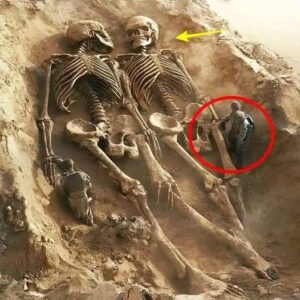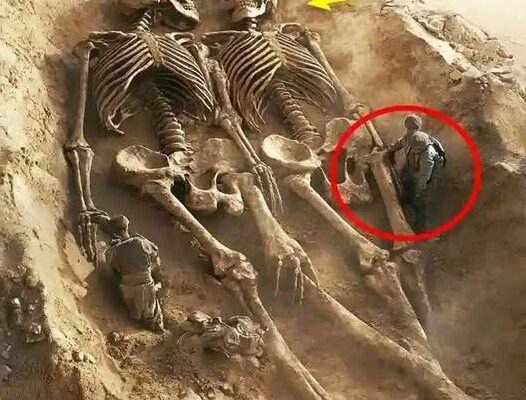In a groundbreaking archaeological discovery that could reshape our understanding of ancient civilizations, an international team of researchers has uncovered two enormous skeletons buried beneath a tomb in the Egyptian desert. The remains, measuring an astounding 30 feet (9 meters) in height, were found beneath a densely compacted layer of earth estimated to be over 5,000 years old. This unprecedented find has ignited intense debate among historians, archaeologists, and geneticists, as it challenges conventional knowledge of human history and the physical limits of early civilizations.
The excavation took place in a remote area of Egypt, where forgotten tombs had lain undisturbed for millennia. Dr. Ahmed el-Hassan, the leader of the research team, described the moment of discovery as nothing short of astonishing. “We expected to find traditional burial chambers, but what we uncovered defies explanation. These colossal figures are remarkably well-preserved, and their size alone forces us to reconsider historical narratives.” The preservation of the remains suggests that they underwent some form of mummification, hinting at their potential cultural or religious significance in ancient Egyptian society.
What makes this find even more intriguing is the anatomical accuracy of the skeletons. Unlike cases of gigantism or other known genetic conditions, these bodies display proportional features, ruling out any known deformities. Their existence has reignited ancient myths and historical texts that reference beings of extraordinary stature. Egyptian lore, including passages from the Book of the Dead, mentions larger-than-life figures who walked among gods and pharaohs, raising speculation that these remains could be linked to those legends.
Experts are divided on what this means for the broader understanding of human history. Some propose that these skeletons belong to an undiscovered or extinct branch of the human species. Others suggest a more symbolic explanation, theorizing that these giants could have been part of an elaborate funerary ritual, possibly representing deities or supernatural entities worshipped by ancient Egyptians. Genetic testing and further analysis are currently underway to determine if these remains share any DNA with modern humans or if they represent an entirely separate lineage.

As scientists continue to unravel the mystery, this discovery stands as a testament to the vast and often mysterious past of human civilization. If verified, these findings could redefine ancient Egyptian history, challenging long-held beliefs about the capabilities, myths, and realities of early human societies.




